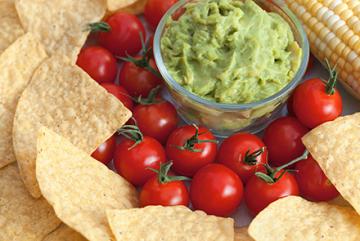Giving Tortilla Chips a Vitamin E Boost

ARS scientists at the National Center for Agricultural Utilization Research in Peoria, Illinois, evaluated the effects of tocotrienols, antioxidant lipids, on frying-oil stability and their content and flavor in tortilla chips. (Peggy Greb, D4083-1)
One day you may be able to eat fried foods like chips with a little less guilt.
An Agricultural Research Service (ARS) study reveals that vitamin E compounds called tocotrienols can be successfully added to frying oil and fried foods, like tortilla chips.
Vitamin E consists of different compounds—antioxidant lipids called tocopherols and tocotrienols. Although tocotrienols are less prevalent in the diet, they’ve been shown to have beneficial biological activities, including lowering cholesterol and reducing the risk of cancer, heart disease, and neurological damage, says chemist Jill Moser, with the ARS National Center for Agricultural Utilization Research (NCAUR) in Peoria, Illinois.
“However, tocotrienols are not commonly found in foods that we eat, and they are different than tocopherols, which make up the vitamin E we consume most of the time.”
To determine whether tocotrienols could be incorporated into foods during frying, Moser and her team added tocotrienols from annatto to sunflower oil used to fry tortilla chips. Annatto, an extract obtained from a tropical fruit, is commonly used to color foods like butter and cheese, textiles, and body care products. They also studied the effect of food processing on the stability of the compound, the oil, and the fried foods.
“We wanted to see if tocotrienols prevent oxidation and degradation of oil during frying and to determine if fried foods could be used to incorporate bioactive lipids such as tocotrienols, which have nutritional benefits that go beyond that of a vitamin or mineral,” says Moser, who works in NCAUR’s Functional Foods Research Unit.
In the study, published in the Journal of Food Science in 2018, Moser and her team evaluated the effects of tocotrienols on frying-oil stability and chip flavor and measured their content in chips. In addition, the team bagged and stored the tortilla chips to determine the compound’s effect on the chips’ shelf life and headspace volatiles. The term “headspace” refers to all the aromas that are in chips after they’ve been stored, Moser explains.
Packaged, stored chips containing annatto tocotrienols had less lipid-oxidation aroma development than chips fried in oil without added tocotrienols, Moser says. “One aroma to describe lipid oxidation would be the smell of oil-based paint or linseed oil. Another term we use is ‘rancid,’” she adds.
A taste panel evaluated the flavor of fresh-fried and stored chips for differences. Panelists found that chips fried in oil containing the annatto tocotrienols had lower amounts of those undesirable flavors and higher levels of the good flavors—like toasted corn flavor—that are associated with tortilla chips.
These experiments showed that tocotrienols from annatto could successfully be added to frying oil and absorbed by fried foods and that their antioxidant activity improves the shelf stability and headspace of the tortilla chips, Moser says.
Future research plans include adding tocotrienols to other types of oils and incorporating them into other foods.— By Sandra Avant, ARS Office of Communications.

